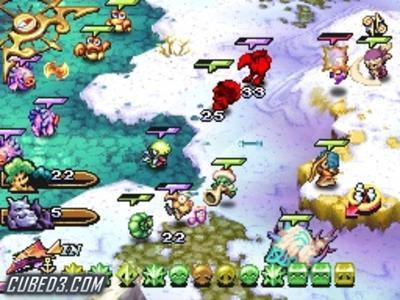
*You can place an AF next to any town AF at any time. Torch of Coral and Rusty Anchor have to be placed on a land space that is touching water in any of the 8 directions. The exceptions are: Sword of Mana (can be placed anywhere), Brooch of Love (can be placed anywhere), and Pirate's Hook (this HAS to be placed on water). *Almost all other AFs have to be placed on land. This AF can be placed on any land space, as long as there is at least 1 land space touching it within the local map. *You always start with AF Mailbox when you start the game. Each battle you complete earns you 1 Weapon Point for the weapon equipped. Unlike Seiken Densetsu 3, there is no Day/Night Cycle (which used the 2 missing Mana elements: Lumina and Shade). You can also advance days by staying at Cafe "Sorry, Carl!" in Geo. Every time you leave an area (whether you leave manually or via a event complete), it costs 1 day. Every time you move from one location to another on the World Map costs 1 day. The week runs as such: Salamander, Aura, Gnome, Jinn, Dyrad, Undine. *Weekday - A week in Legend of Mana is 6 days. You earn more based upon your weapon and ability choices. You start with 1, determined by the weapon you choose at the start of the game. During the technique, you are invincible. *Technique - These are the super flashy actions that are tied into the trigger buttons. Easiest with two players, but possible with 1 player using certain weapons. *Stunlock - Hitting an enemy rapidly enough that they are unable to make an action. This determines what happens and when it happens, seemingly randomly. Every enemy has various strengths and weaknesses to the different elements, which influence its strength (level). As you place AFs, the levels of the land you placed and the areas around it influence each other. Each area has various levels of the elements, from 0-3. *Mana Level - There are 8 elements in the game: Undine (Water), Gnome (Earth), Salamander (Fire), Syphid (Wind), Lumina (Light), Shade (Shadow), Aura (Gold), and Dryad (Tree). *Local Map - This is the 6圆 grid you choose to place your AFs on during the game and is a small portion of the world map (which is 24x24). Last is the mana level of the land, which is a combination of the land itself as well as any neighbors in the compass positions from it. The farther (in spaces you have to walk), the stronger. First is the order in which a land was placed. *Land Level - The level of shops and enemies is determined by a few factors.

However, due to how the battle system works, it's mostly inconsequential for a speedrun. *Battle Arena - This is the area you are locked into when you fight enemies in each area of the game. Each battle you complete earns you 1 Ability Point for the ability equipped. I get these mostly from completing events, but a few are earned in other ways. These create the various lands of the game. You do NOT need to use them in battle, just have them equipped. You start with 8 of these and earn more as you equip certain ones and win battles. These allow you to do things like counterattack, jump, and more.
.png)
*Ability - These are quick actions tied to Triangle and Circle (in the US Version) or Square and X (in the Japanese version). I'm going to be documenting a lot of them, both for future runners as well as for the viewer, along with some terms. When playing Legend of Mana, you need to know the rules of the game. It also has the potential for crashes and other issues. Fast Disc Speed was not used as it breaks the ending and thus makes the in-game timer unreliable.

Legend of mana new game plus ps2#
This game is played on a PS2 Slim (SCPH-70000) and run on Standard Disc Speed. It depended a lot on luck, but I kept pushing until I got the luck I needed to make this run happen. Since my 1:49 run, I found some more changes to the route, leading to crushing some of the early game times. Though I've played this game over and over, all of these were necessary to push this speedrun to its limits. And also much help to Polsy who helped me translate some items from the Ultimania Guide.

This includes RCrowder for the Technique List, Myst Erik Ery for the Artifact Guide and Monster Drop Guide, and Nemesis and SeanKelson for their general walkthroughs. First, I'd like to thank the writers of several great FAQs, for without them, this run wouldn't have been amazing.


 0 kommentar(er)
0 kommentar(er)
